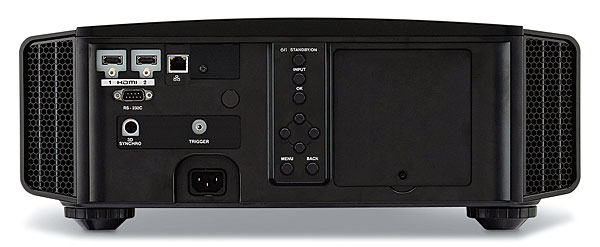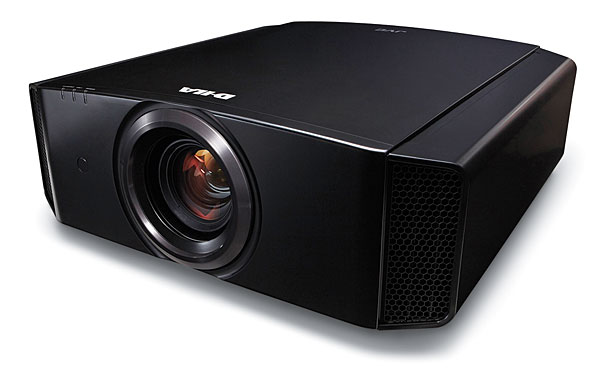JVC DLA-X550R 3D D-ILA Projector

AT A GLANCE
Plus
Very good brightness for the price
Excellent contrast
Fully motorized lens
controls
Minus
Slight enhancement artifacts
THE VERDICT
JVC’s DLA-X550R continues the company’s streak of producing high-value projectors that deliver high-contrast images.
Most projector manufacturers refresh their product lines every fall like clockwork, but JVC opted to sit things out for 2014. The main reason (I suspect) was the state of flux surrounding the HDMI standard, which at that point was evolving to a new 18-gigabit-per-second version designed to accommodate a full range of 4K/Ultra HD bells and whistles, including 60-hertz frame rate, 4:4:4 color sampling, and high dynamic range.
Released at the tail end of last year, the DLA-X550R ($3,999) is the entry-level model in JVC’s 2015-16 lineup. Along with having the latest and greatest HDMI connections (HDMI 2.0a), it has a 265-watt high-power lamp and new D-ILA (JVC’s moniker for LCOS) imaging devices that let the projector beam 30 percent brighter images than its predecessor, the DLA-X500R. While those D-ILA chips are technically specified as having 1080p resolution, JVC’s e-shift4 technology enables the DLA-X550R and other JVC projectors to deliver what the company calls “4K precision” images. The projector can actually accept a true 4K source (and upconverts lesser sources to 4K). It then divides the true or upconverted 4K source into two separate arrays of subpixels, displaying one array first on its 1080p imaging chips, then displaying the second array a fraction of a second later by shifting it diagonally on the D-ILA device to boost apparent resolution to 3840x2160. JVC projectors with e-shift are a different animal than projectors containing imaging chips with an actual 4K pixel count. As JVC explains it, the data in the original 4K signal is split into two frames, each with different pixels. The projector runs at double speed, displaying each frame sequentially, with the second frame shifted horizontally and vertically by one half pixel. The temporal delay is so short that the eye’s persistence of vision blends the two subpixel arrays together. The process also serves to minimize the visible pixels you’d otherwise see from a 1080p projector when you’re sitting close to the screen.

The DLA-X550R is compatible with HDR10 high dynamic range content. (It won’t support Dolby Vision because, JVC points out, there is currently no Dolby Vision specification for projectors, only flat-panel TVs.) When it recognizes HDR10 via its HDMI 2.0a inputs, the projector should (among other things) automatically select its “D” gamma preset to reproduce the SMPTE 2084 gamma curve associated with HDR.
This projector is also 3D ready: All you need to add is JVC’s optional RF active-shutter 3D glasses ($180) and RF 3D emitter ($100). Like its predecessor, it features an Intelligent Lens Aperture setting to dynamically adjust contrast ratio. There’s also a fixed manual mode for the iris, but even it its automatic setting the aperture can be set for a specific maximum brightness level.
The JVC has a boxy, basic, black look. Sure, I’ve seen other models with a prettier design, but then again, a projector is meant to be installed near the ceiling at the back of your room, where you don’t see it. Not surprising for an entry-level model, the DLA-X550R lacks the motorized lens cover found on the company’s pricier projectors, though it does have motorized zoom, focus, and lens-shift controls. Connections on the back panel include a pair of HDMI inputs, LAN and RS-232C ports for hooking up to control systems, a trigger output, and a 3D sync jack for the optional RF 3D emitter.
The remote control is compact and has a fully backlit keypad with a well-placed Light button—at thumb-level when you grab the handset. Direct input buttons are provided, along with buttons to directly select Lens Memory (a feature used for easy switching between 2.35:1 and 16:9 images on a 2.35:1 screen) and the projector’s three preset and three user-defined picture modes. Other controls allow you to easily switch Gamma presets and Lens Aperture modes, as well as tweak the Multi Pixel Control (MPC) image enhancement settings on the fly.
Setup
I placed the DLA-X550R on a high shelf at the back of my theater room, approximately 12.5 feet from a 90-inch-diagonal, 1.1-gain Stewart Filmscreen Cima Neve screen. Pressing the Lens Control button on JVC’s remote lets you switch between the focus, zoom, and lens-shift modes, each of which has its own internal test pattern. While I left e-shift switched on for most of my viewing, I was glad to discover that it could also be shut off. This helped with focus, since e-shift’s pixel-eliminating magic made it otherwise difficult to tweak that setting.

The DLA-X550R lacks the THX picture modes featured on step-up models in JVC’s projector line. However, out-of-the-box image quality was mostly accurate with the Cinema mode selected. The main thing that required tweaking was Gamma, a parameter that could be tweaked with a high level of control using a Custom Gamma menu with White, Red, Green, and Blue adjustments that feature sliders for dark and bright levels.
Although the projector’s measured grayscale and color points were within acceptable range, I used the RGB Gain and Offset sliders in the Color Temperature menu and the color management system controls in the Color Profile menu to make minor adjustments. JVC’s 6-Axis Color Management System—a new feature making its debut in the current lineup—made it easy to fine-tune color settings by providing Axis Position, Hue, Saturation, and Brightness controls for primary and secondary colors.
- Log in or register to post comments






































































